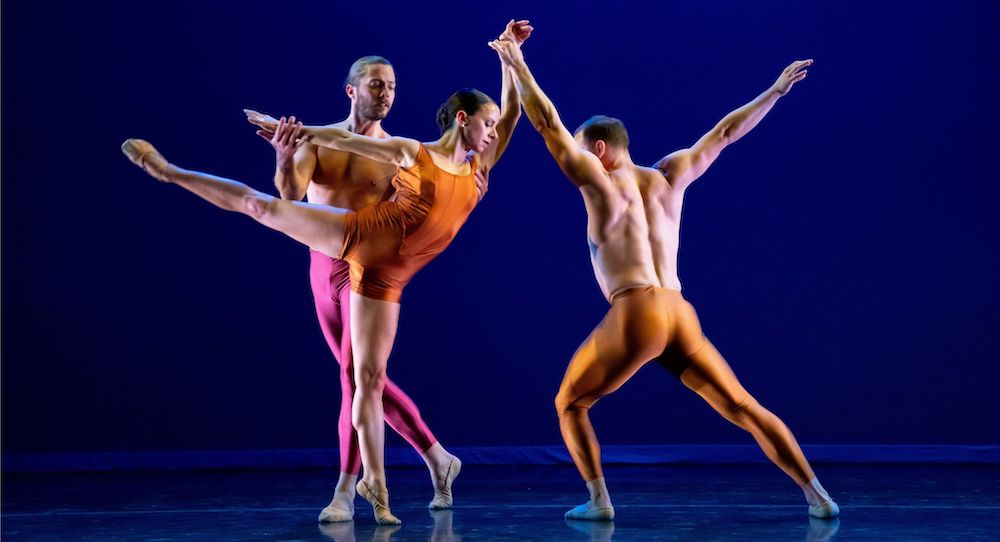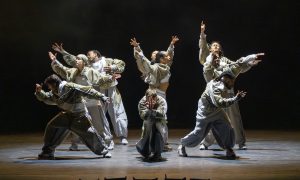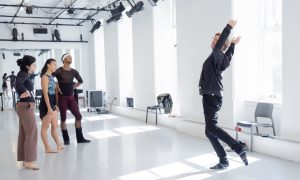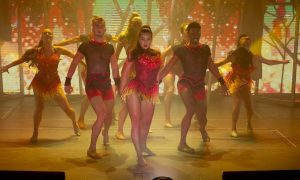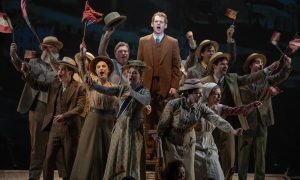The Keats Theatre at St. Andrew’s School, Barrington, RI.
March 22, 2025.
Smells, sounds, images, the way light falls…we never know what sensory info might connect us with profound memory. Dance has a deep tradition, on the concert stage and far before in human history. Beyond that, the visceral and wordless understanding that the art form transmits can arguably illustrate ancient human truths: of myth, mysticism, ties with the earth and each other which transcend the modern world’s structures.
Through four works of very varied themes, Newport Contemporary Ballet’s Mystical Ways nevertheless all connected to this theme of deep memory. All works offered a sense of honoring and remembrance – even redefining, reclaiming such memory.
Quite sadly, there was memory that connected closely with the company itself; they recently lost company member Edgardo Torres Estremera (at an age far, far too young). The company dedicated all performances in the run to him. I like to think he smiled on from above, proud to see his friends and colleagues carrying on the work that he so dearly loved. Sharing story and connecting souls through the moving body — very much a wonderful way to do just that.
Artistic Director’s Danielle Genest’s Evoked opened the program: mystical indeed, full of soulfulness and enticing mystery. A solo memorably danced by Deanna Gerde, it was wonderful to see her back at full performance prowess after injury recovery. Wearing a tunic-like white dress (designed by Eileen Stoops), gaze sharply focused, executing gestures of pure pathos, she reflected Isadora Duncan – who herself, a century and more ago, reflected an ancient divine feminine.
Gerde moved with a graceful gravitas fully carrying the weight of that idea, that tradition. Reaching, leaping, lunging in turn, she offered both precision and expansion. Both movement and score evoked a solemn searching, a grounded curiosity. Gerde’s persona, as human, rode the cosmic and timeless dance between myriad opposites. The work honored that timeless journey as well as the deep tradition of exploring it.
Marika Brussel’s tenacious The Liminal Hour opened space for Macbeth’s witches to tell their own story – an intriguing concept in this age of reconsidering “villain” narratives. The work began with a slow rise and undulation, like kelp flowing in gentle tides. Abstract projections on the backdrop reminisced that fluid, earth-tied sense. The witches emerged as central figures before long. Just as with Gerde in the opening piece, their movement quality and presence delivered a spirit of the divine feminine. These women, these “wicked witches”, embraced their sacredness.
They moved with interconnectedness, but also autonomy. A poignant duet with Lauren Difede and Ben Rabe deepened that sense, with them leaving and returning to sharing each other’s weight. In this convergence and divergence, other dancers entered and exited – relationships evolving and dissolving in turn. Calm moved into organized freneticism, and back again. Such are nature’s cycles.
A connecting thread through it all was the score’s heartbeat (from Ryan Cockerham), the movement vocabulary embodying its fluttering tones. Shadowy lighting (by Stephen Petrilli) and elegantly simple costuming (by Alana Frutkoff) supported the mystical, fantastical sense at hand…we were in a witches’ story, after all, tied to so many other timeless stories and traditions.
To boot, the central witch figures carried lamps at the end: glimmers through darkness. They turned the lamps off, one-by-one, but the glimmers still resonated through the space. These women’s light – their stories, their divine magic – reverberated.
Shane Farrell’s Return to One came after an intermission, an embodiment of the myth wherein the ancient Greek god Zeus, fearing human power, separated connected souls – leading to a fate of them never being truly at peace until they once again found their “other half.” Speaking of interconnectedness, and quite fitting with theme, there was an immediate sense of synchronicity and harmony between the personas in the piece, danced by Difede, Rabe and Gregory Tyndall.
One may at first think it strange for a trio to make visceral this story of two innately connected souls. Yet a third mover allowed for illustration of two connected versus one alone – which Farrell keenly explored. Opposite facings reflected the image of Janus: two joined faces gazing directly opposite ways. Fresh gestural choices – such as hands reaching in between heads releasing to opposing sides – infused aesthetic daring of the present to this very old tale. The trio delivered it all with full aplomb.
As always, Difede moved with a uniquely strong and solid fluidity. Rabe and Tyndall also offered their own wonderfully individual movement signatures. These separate qualities came together quite cohesively, helping to create that feeling of an intrinsic bond. As lights faded down to end the work, Difede and Rabe softly leaned into each other as Tyndall raised arms skyward – as if blessing two souls reuniting.
Danielle Genest’s evocative, impassioned The Voice of Silence closed the program. Program notes expressed that “defined as the absence of sound, silence is paradoxically so full…of thought, emotion, conflict, struggle, clarity, wisdom, and peace.” A striking image of hands slowly reaching up opened the piece. The hands moved right and left, and then dancers’ spines cascaded downward in turn. From there, sections continued with a seamlessness reminiscent of stream-of-consciousness thoughts – flowing one into the other in those silent pockets of our lives. Those pockets, which this work spotlighted and honored, seem all the rarer in our lives.
Helping to build that seamlessness was Genest’s keen sense of timing. It created a steady rhythm, one reverberating along with the tonally multilayered score (from John Tavener and Ola Gjeilo). She also has a unique capacity with staging; within frenetic sections, dancers moving in their own relationships with time and space, the stage picture remained clean and clear.
In other visuals, voluminous skirts (costume design by Gerde) added dimension to the dynamic movement vocabulary: lines and curves meeting and deviating. The company’s two Apprentices, Amelia Bednar and Abigail Molina, exhibited impressive refinement in their movement vocabulary. I look forward to continuing to watch them grow as artists.
An ending section had the ensemble reaching arms wide, fingers splayed, hearts lifted, walking in a circle: poised to receive. They moved with a new clarity and spaciousness – one beyond clouds of thought, where there might actually be true silence. In this age of endless notifications and all too many ways to stay technologically connected, that silence is something to savor.
It’s also something to also honor – just as this program lauded the continuing of ancient traditions, reclaiming of stories, and someone we lost several decades too soon. Thank you to Newport Contemporary Ballet for presenting dance to remember, to celebrate, to explore the mystical in stories past and present.
By Kathryn Boland of Dance Informa.


